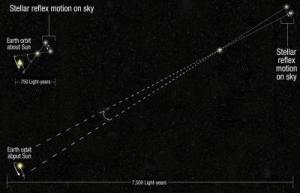Apr 11 2014
Using NASA's Hubble Space Telescope, astronomers now can precisely measure the distance of stars up to 10,000 light-years away -- 10 times farther than previously possible.
 By applying a technique called spatial scanning to an age-old method for gauging distances called astronomical parallax, scientists now can use NASA's Hubble Space Telescope to make precision distance measurements 10 times farther into our galaxy than previously possible. Credit: NASA/ESA, A.Feild/STScI
By applying a technique called spatial scanning to an age-old method for gauging distances called astronomical parallax, scientists now can use NASA's Hubble Space Telescope to make precision distance measurements 10 times farther into our galaxy than previously possible. Credit: NASA/ESA, A.Feild/STScI
Astronomers have developed yet another novel way to use the 24-year-old space telescope by employing a technique called spatial scanning, which dramatically improves Hubble's accuracy for making angular measurements. The technique, when applied to the age-old method for gauging distances called astronomical parallax, extends Hubble's tape measure 10 times farther into space.
"This new capability is expected to yield new insight into the nature of dark energy, a mysterious component of space that is pushing the universe apart at an ever-faster rate," said Noble laureate Adam Riess of the Space Telescope Science Institute (STScI) in Baltimore, Md.
Parallax, a trigonometric technique, is the most reliable method for making astronomical distance measurements, and a practice long employed by land surveyors here on Earth. The diameter of Earth's orbit is the base of a triangle and the star is the apex where the triangle's sides meet. The lengths of the sides are calculated by accurately measuring the three angles of the resulting triangle.
Astronomical parallax works reliably well for stars within a few hundred light-years of Earth. For example, measurements of the distance to Alpha Centauri, the star system closest to our sun, vary only by one arc second. This variance in distance is equal to the apparent width of a dime seen from two miles away.
Stars farther out have much smaller angles of apparent back-and-forth motion that are extremely difficult to measure. Astronomers have pushed to extend the parallax yardstick ever deeper into our galaxy by measuring smaller angles more accurately.
This new long-range precision was proven when scientists successfully used Hubble to measure the distance of a special class of bright stars called Cepheid variables, approximately 7,500 light-years away in the northern constellation Auriga. The technique worked so well, they are now using Hubble to measure the distances of other far-flung Cepheids.
Such measurements will be used to provide firmer footing for the so-called cosmic "distance ladder." This ladder's "bottom rung" is built on measurements to Cepheid variable stars that, because of their known brightness, have been used for more than a century to gauge the size of the observable universe. They are the first step in calibrating far more distant extra-galactic milepost markers such as Type Ia supernovae.
Riess and the Johns Hopkins University in Baltimore, Md., in collaboration with Stefano Casertano of STScI, developed a technique to use Hubble to make measurements as small as five-billionths of a degree.
To make a distance measurement, two exposures of the target Cepheid star were taken six months apart, when Earth was on opposite sides of the sun. A very subtle shift in the star's position was measured to an accuracy of 1/1,000 the width of a single image pixel in Hubble's Wide Field Camera 3, which has 16.8 megapixels total. A third exposure was taken after another six months to allow for the team to subtract the effects of the subtle space motion of stars, with additional exposures used to remove other sources of error.
Riess shares the 2011 Nobel Prize in Physics with another team for his leadership in the 1998 discovery the expansion rate of the universe is accelerating -- a phenomenon widely attributed to a mysterious, unexplained dark energy filling the universe. This new high-precision distance measurement technique is enabling Riess to gauge just how much the universe is stretching. His goal is to refine estimates of the universe's expansion rate to the point where dark energy can be better characterized.